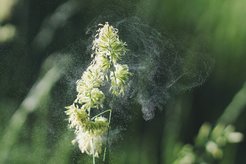Precisely predicting allergenic pollen with AI
The Technische Universität Ilmenau is leading a research project that aims to use artificial intelligence to accurately predict the spread of pollen. In order to improve allergy prevention, experts from the university, the Max Planck Institute for Biogeochemistry in Jena, the Helmholtz Center for Environmental Research in Leipzig and Leipzig University Hospital are bringing together the latest interdisciplinary findings from a wide range of fields: from medicine and botany to data processing. The precise predictions of when which pollen pollutes the air and in what concentration should make it possible in future to take effective precautionary measures for the benefit of people who suffer from pollen allergies. The "PollenNet" project, which has just been launched, is scheduled to run for six years and is being funded by the Carl Zeiss Foundation with five million euros.
Diese Pressemitteilung wurde uns freundlicherweise von der TU Ilmenau zur Verfügung gestellt.

Almost a third of the world's population suffers from pollen-related respiratory allergies - and the trend is rising. For the people affected, the situation is becoming more stressful from year to year: climate change is causing allergy-causing plants to flower earlier and earlier. In addition, the increased concentration of carbon dioxide in the atmosphere is also leading to increased plant growth and therefore supposedly to higher pollen concentrations in the air. Not only do many people suffer from this, but the economic damage is also enormous: in Germany alone, allergic diseases caused by pollen cause costs in the multi-million euro range every year.
The aim of the "PollenNet - phenology-based pollen predictions and EEG-based assessment of allergic reactions using AI" project is to continuously provide precise information and predictions on the spread of allergenic pollen in order to better protect the health of affected people. In order to be able to predict the transport and spread of pollen with high precision, internationally renowned experts from various fields are working together for six years under the leadership of TU Ilmenau: Medicine, Botany and Ecology, Data Processing and Artificial Intelligence as well as Fluid Mechanics and Turbulence Theory. The researchers will expand artificial intelligence methods and develop new models and use scientific experiments to gain new insights into the individual exposure of people to pollen. Their common goal: precise, comprehensive pollen monitoring.
TU Ilmenau is contributing expertise from five scientific fields: artificial intelligence, processing and analysis of big data and data streams, fluid mechanics and measurement technology, bioelectrical and biomagnetic measurements and data evaluation as well as tensor-based signal processing. The Max Planck Institute for Biogeochemistry in Jena has developed the Flora-Incognita app in collaboration with the TU Ilmenau to obtain real-time information on phenology, i.e. the periodically recurring developmental phenomena of allergenic plants over the course of the year, and provides insights into predicting the spread of species. The Helmholz Center for Environmental Research in Leipzig is contributing its many years of experience in pollen research and Leipzig University Hospital its outstanding expertise in the field of experimental and clinical allergy research.
The President of TU Ilmenau, Prof. Kai-Uwe Sattler, sees the PollenNet project as a good example of how basic university research can be combined with application-oriented research: "With this project, we want to demonstrate how joint, interdisciplinary work from very different fields of research can address not only scientific issues, but also problems of everyday life."
Project leader Prof. Patrick Mäder, Head of the Data-Intensive Systems and Visualization Group
at TU Ilmenau, is confident that PollenNet will make a contribution to improving public health: "I am very proud to have brought together top international researchers who share my motivation to help millions of people who often suffer greatly from their hay fever and other pollen allergies. With accurate predictions of allergenic air pollution, we want to make it possible in future to take effective preventive measures to significantly improve the quality of life of those affected, for whom their suffering is an enormous burden. We hope to achieve a real breakthrough in pollen research."
About the Carl Zeiss Foundation
The Carl Zeiss Foundation has set itself the goal of creating scope for scientific breakthroughs. As a partner of excellent science, it supports basic research as well as application-oriented research and teaching in the STEM disciplines (mathematics, computer science, natural sciences and technology). Founded in 1889 by the physicist and mathematician Ernst Abbe, the Carl Zeiss Foundation is one of the oldest and largest private science-promoting foundations in Germany. It is the sole owner of Carl Zeiss AG and SCHOTT AG. Its projects are financed from the dividends distributed by the two foundation companies.












